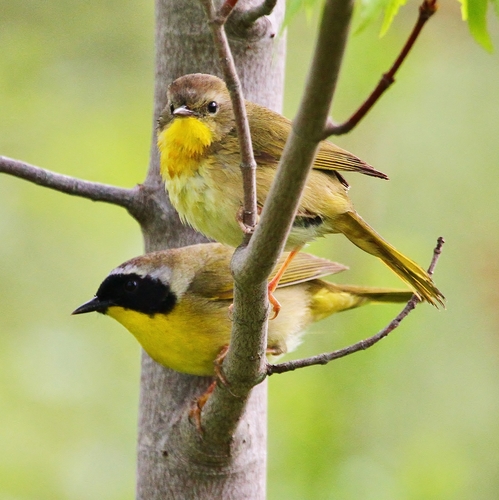
Common Yellowthroat
The Common Yellowthroat (Geothlypis trichas) is a small, active songbird widespread across North America. It is easily recognized by the male's bright yellow throat and black facial mask, a striking contrast against its olive-green back. This warbler plays a vital role in controlling insect populations, particularly in wetland and shrubby habitats. While not typically considered culturally significant in the same way as some larger birds, its vibrant appearance and lively song make it a welcome sight and sound for birdwatchers and nature enthusiasts.
11-13 cm
Length
15-19 cm
Wingspan
Least Concern
Conservation Status
Distribution
The Common Yellowthroat breeds across North America, from southern Canada to central Mexico. During winter, most populations migrate to the southern United States, Mexico, Central America, and the Caribbean. They exhibit a wide altitudinal range, from sea level to over 3,000 meters.
Lifespan
Typical lifespan in the wild is 2-3 years, although some individuals may live longer. Records of banded birds suggest a maximum lifespan of around 10 years.
Common Yellowthroat's Habitat
Habitat Types
Marshes, Wet meadows, Thick brush, Riparian areas, Forest edges
Climate Zones
Temperate, Subtropical, Tropical
Adaptations
Common Yellowthroats are well-adapted to dense, low vegetation. Their small size and agility allow them to maneuver through thickets, while their strong legs are suited for hopping and clinging to stems. They are often found near water sources.
Variations
There are numerous recognized subspecies (around 13) of the Common Yellowthroat, differing subtly in plumage color and size, primarily across their extensive geographic range. For example, some island populations show slight variations compared to mainland birds.
Appearance
Breeding Plumage
Males in breeding plumage have a bright yellow throat and breast, a black facial mask bordered above by a white or pale gray band, and olive-green upperparts. Females and immature birds lack the black mask and are generally duller, with a yellowish throat and olive-brown upperparts. Non-breeding males may have a less distinct mask.
Seasonal Feather Changes
Plumage is brightest during the breeding season. After breeding, birds molt into a duller, less contrasting plumage.
Sex Based Plumage Differences
Significant. Males have the distinctive black mask, while females do not.
Notable Features
Black facial mask (males), Bright yellow throat, Olive-green upperparts, Rounded tail
Diet and Feeding
Primary Foods
Insects, Spiders, Larvae, Small invertebrates
Foraging Behavior
Common Yellowthroats primarily forage by gleaning insects from foliage and low vegetation. They actively hop and flit through dense cover, searching for prey. They may also hover briefly to pick insects from leaves or catch them in mid-air.
Specializations
Their slender, pointed bills are well-suited for picking small insects and other invertebrates from leaves and stems.
Seasonal Diet Variations
While primarily insectivorous, they may occasionally eat small fruits or seeds, particularly during migration or in winter when insects are less abundant.
Behavior
Social Structure
Common Yellowthroats are generally solitary or found in pairs during the breeding season. Outside of breeding, they may be found in loose flocks, particularly during migration.
Communication
Distinctive *witchity-witchity-witchity* song, Sharp *chip* or *check* calls, Flight displays, Wing-fluttering
Migration
Most Common Yellowthroat populations are migratory, traveling south for the winter. They migrate at night, often in mixed-species flocks. Migration routes vary, but many follow coastlines or major river valleys.
Territorial or Group Behaviors
Males are highly territorial during the breeding season, defending their territories against other males through song and aggressive displays. They are less territorial outside of the breeding season.
Conservation
Threats
Habitat loss and degradation (wetlands, shrublands), Pesticide use, Collisions with buildings and windows, Climate change (altering habitat availability)
Protection Programs
Wetland conservation and restoration efforts, Migratory Bird Treaty Act protection, Some regional and local habitat protection initiatives
Local National Laws
Protected under the Migratory Bird Treaty Act in the United States, Canada, and Mexico.
Population Trend
Stable
Population Estimates
The global population is estimated to be around 98 million individuals.
Interesting Facts
They are one of the most widespread warblers in North America.
Their adaptability to various habitats contributes to their wide distribution.
The male's black mask is unique among North American warblers.
This feature makes them easily identifiable.
They often nest very close to the ground.
This makes their nests vulnerable to predators and flooding.
Common Yellowthroats are known to be parasitized by Brown-headed Cowbirds.
Cowbirds lay their eggs in the nests of other birds, and the host parents often raise the cowbird chicks at the expense of their own young.
Faqs about Common Yellowthroat
What does a Common Yellowthroat sound like?
The male's song is a distinctive, rhythmic *witchity-witchity-witchity*. They also have sharp *chip* or *check* calls.
Where can I see a Common Yellowthroat?
Look for them in dense, low vegetation, often near water, such as marshes, wetlands, and thickets. They are widespread across North America during the breeding season.
Do Common Yellowthroats visit bird feeders?
They are not typical feeder visitors, as they primarily eat insects. However, they might occasionally be attracted to suet or mealworms.
Are Common Yellowthroats endangered?
No, they are classified as 'Least Concern' by the IUCN, meaning their population is currently stable.
Copyright @ Nature Style Limited. All Rights Reserved.
 English
English